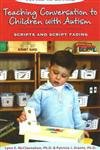Synopsis
Scripting is a teaching method designed to help children and adults with autism spectrum disorders (ASDs), who are nonverbal or who are verbal but don't initiate conversation, to initiate conversation. The authors draw on years of experience using scripts in their own clinic, and include many case studies that show how scripts have worked. The book defines scripts as an audiotape or written word, phrase, or sentence that enables young people with autism to use speech to start and continue conversations. At first a child is taught to play the recording of a word for an adult, and then get a reaction from the adult. (e.g., if he plays the script juice, the adult will give him a sip of juice or if he plays the script ball, the adult will play ball with him). Later on, the child is taught to play the script and then say the word himself (and get the reward from the adult). As the child becomes better at talking, scripts are lengthened to become phrases -- want juice or play ball --- and then sentences. And once the child can read, scripts are written instead of recorded. As the child masters sets of scripts, the adult begins to diminish ( fade ) the prompts. If the script was recorded, words are gradually deleted from the recording. (e.g., if the script started out saying, Where is mom? they will re-record it so it just says Where is and then Where ---? At this point, the child should fill in the blanks.
About the Author
Drs. McClannahan and Krantz are Executive Directors of the Princeton Child Development Institute, a community-based, nonprofit program in New Jersey that offers science-based services to children, youths, and adults with autism. They are the authors of ACTIIVITY SCHEDULES FOR CHILDREN WITH AUTISM: Teaching Independent Behavior (Woodbine House, 1999) and many journal articles and book chapters, and their applied behavior analysis research on autism intervention is recognized both nationally and internationally.
"About this title" may belong to another edition of this title.
